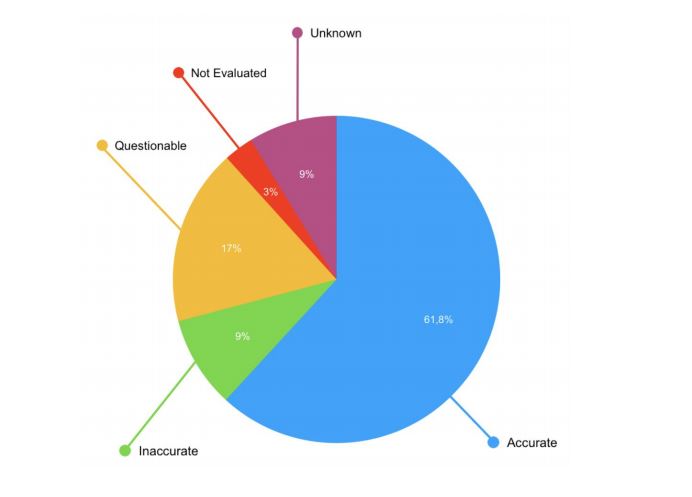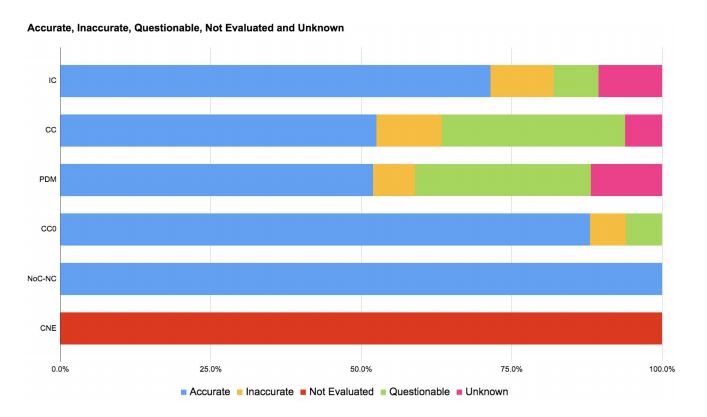62% of rights statements are accurate - together, we can improve on that
Recent research by Kennisland identified that 62% of content published via Europeana has accurate rights statements, and that there are common issues that lead to the 38% that are inaccurate.

- Title:
- Court in session from BL Harley 2681, f.2
- Creator:
- Marcus Tullius Cicero
- Date:
- 1483
- Institution:
- British Library
- Country:
- UK
- Copyright:
- Public Domain
Accurate rights statements help users of cultural heritage understand how they can reuse the content they discover. In this blog, we explain how Europeana is responding to the recommendations in Kennisland's report, and what cultural heritage institutions can do to increase the confidence people can have when reusing cultural content.
Overview of results showing the accuracy of rights statement applied to content published via Europeana, from Research Paper: The accuracy of Rights Statements, Kennisland
Together we’re steadily improving the labelling of cultural content
Collectively, we have come a long way since research as first undertaken into the use and accuracy of rights statements in 2013. Back then, 30% of objects didn't have a rights statement - today 100% of objects do. We also saw evidence that a large number of collections contained objects that were not correctly labelled. Today, Kennisland estimates this figure to be around 38% and points us to a recurring issues of incorrect labelling of objects using Creative Commons licences and the Public Domain Mark. And in this time we've seen some large collections opened up such as SMK and Hispana.
Accuracy of rights statement per category, from Research Paper: The accuracy of Rights Statements, Kennisland
The research report, undertaken over the summer of 2017, continues our effort to better understand how accuracy rights statements are applied. Can we assess the accuracy of the statements used, and when we find inaccurate statements is it possible to identify why? The research undertaken, was based on extrapolation, differentiated between inaccurate statements. For example where an object was labelled with a Public Domain Mark (PDM) and the data absolutely confirms that the object is in copyright. And those that are questionable such as where the data published does not appear to support the selection of a Creative Commons licence. It also highlights the issue of objects that are not protected by copyright, and those where the copyright has expired being labelled with a Creative Commons licence.
How Europeana is responding to the report’s recommendations
In 2018 we're going to focus on improving the support, information and training we offer to data partners. We want to highlight the common issues faced when applying rights statements such as looking at what copyright applies to, and providing support to data partners on how to address them. And we will promote the use of statements from the RightsStatements.org consortium.
The copyright community will be formalised to provide a space to share best practices - for example how to seek permission to apply Creative Commons licences - and knowledge between professionals. And we’ll be looking at improving our own policies and practices, such as updating the documentation provided to data partners during the ingestion process.
Working together - how Europeana and data partners can improve the accuracy of rights statements
There is a limit to what the data analysis can tell us - it can’t for example tell us about your experience applying rights statements. Or how well you feel that you understand the copyright laws that apply to your collections, or if you have adequate resources available to research and apply rights statements correctly.
You can help us improve the support we can offer by talking to us about your experiences applying rights statements. Do you recognise the issues highlighted in this report in your own data? Get in touch and together let’s improve Europeana Collections one rights statement at a time.
Read the full research paper by Kennisland
Footnote on the research paper
Methodology
Kennisland constructed a methodology for qualitative research in which they individually assessed the accuracy of the rights statements of a representative sample of 1,462 digital objects made available via Europeana. The results from the sample give an indication of the accuracy of the rights statements of the entire database of Europeana. The research was limited to determining the accuracy of the rights statements by looking at the available data on Europeana and the website of the data partner.
And the results?
The results show that at least 61.8% of the rights statements were accurately applied and at least 9.1% were inaccurate based on the available information. The accuracy of 17.4% of the rights statements is questionable, while for 8.8% of the rights statements it was not possible to determine the accuracy. 3% of the rights statements have not been evaluated.
There are two categories – objects with a public domain statement and objects with a Creative Commons statement – where the accuracy is significantly lower in comparison to the other categories. The accuracy in these two groups is close to (at least) 50%.
So, what next?
Through policy and training, Europeana can support the improvement of the quality of the rights statements, but cannot by itself completely solve the underlying problems concerning their accuracy.The accuracy of rights statements is in the first instance the responsibility of the institutions that make digital objects available via Europeana (the data partners).
Kennisland have put together some recommendations for Europeana, which are intended to open up a dialogue with data partners about how to improve the accuracy of rights statements.



